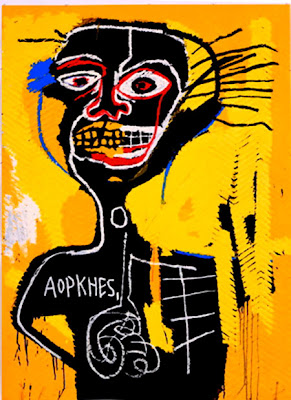Despite his work's ‘unstudied’ appearance, Basquiat very skillfully and purposely brought together in his art a host of disparate traditions, practices, and styles to create a unique kind of visual collage, one deriving, in part, from his urban-American origins, and in another a more distant, African-Caribbean heritage.
For some critics, Basquiat's swift rise to fame and equally swift and tragic death by drug overdose epitomizes and personifies the overly commercial, ‘hyped up’ international art scene of the mid 1980s, a cultural phenomenon that for many observers was symptomatic of the largely artificial, yet, for some, perversely profitable ‘Bubble Economy’ of the era.
Basquiat's work is an example of how American artists of the 1980s could reintroduce the human figure in their work after the wide success of Minimalism and Conceptualism, thus establishing a dialogue with the more distant tradition of 1950s Abstract Expressionism.
The recipient of posthumous retrospectives at the Brooklyn Museum (2005) and the Whitney Museum of American Art (1992), as well as the subject of numerous biographies and documentaries, including Jean-Michel Basquiat: The Radiant Child (2010; Tamra Davis, Dir.), and Julian Schnabel's feature film, Basquiat (1996; starring former friend David Bowie as Andy Warhol), Basquiat and his counter-cultural example persist.
1983 Horn Player
1983 Mona Lisa
1983 The Italian
1983 Untitled
1983 Untitled (Leonardo and his Five Grotesque Heads)
1984 Flexible
1984 Gastruck
1984 Untitled
1984 Untitled (Skull)
1985 Anthony Clarke
1985 Overrun
1985 Tenor
(I don't have titles or dates for the following:)
Jean-Michel Basquiat died of a heroin overdose in 1988.


















No comments:
Post a Comment